Video
72K notes
·
View notes
Text
AUSTRALIA IS BURNING
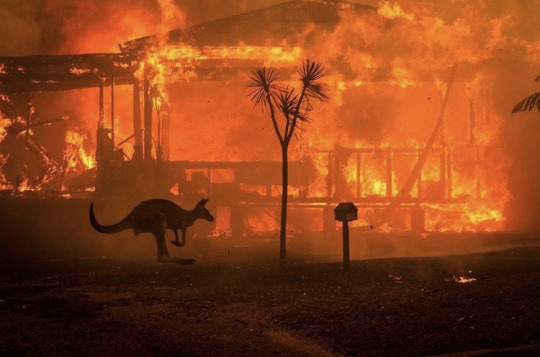
The disastrous wildfires taking place in Australia are not getting enough attention. People, animals & parts of Australia are dying, and there isn’t a sign that it is going to stop soon. These wildfires are 4 times worse than the amazon fires, and yet are receiving SO much less attention.
The facts:
There are currently 200 wildfires across Australia (expected to drastically increase).
So far, almost half a MILLION animals have been killed (including a third of its koala bears).
Over 20 people have lost their lives, with dozens more missing.
5 million hectares have been burned (the Amazon was 900,000).
Australian Priminister Scott Morrison refuses to accept that this is as a result of a climate crisis.
The wildfires have reached (and started to melt) glaciers in distant New Zealand.
Thousands of homes have been burned to the ground, resulting in evacuations.
The amount of Australia burnt is equivalent to the entire country of Belgium.
How you can help:
Reblog this! Help this post reach a wider audience which will show more people what they can do to help.
Organisations that you can support (instagrams linked):
Wildlife rescue
Vic fire service
NSW fire service
Red Cross
Celeste Barber has also brilliantly set up a fundraiser in order to support the firefighters, and has amazingly raised $18.8 MILLION Australian dollars so far (this is rapidly increasing). You can support by donating anything you can to HERE
If you can’t donate, please show your support by reblogging this & raising as much awareness as you can. This is a devastating situation which needs as much attention as it can. Thank you!
5K notes
·
View notes
Photo





Art for Evilbook 2 by selected artists: Anastasia Tupikova, Yulia Ptitsyna, Axel Sauerwald, Denis Zolotarevich, Maksim Kneht
3K notes
·
View notes
Text
"Sabed que todas las cosas son como esto:
un espejismo, un castillo de nubes, un sueño, una aparición, sin esencia, pero con cualidades que pueden verse.
Sabed que todas las cosas son como esto:
como la luna en un cielo brillante en algún lago transparente reflejada, aunque a ese lago la luna nunca se ha desplazado.
Sabed que todas las cosas son como esto:
como un eco que deriva de música, sonidos y llanto, y sin embargo en ese eco no hay melodía.
Sabed que todas las cosas son como esto:
como un mago que crea ilusiones de caballos, bueyes, carros y otras cosas, nada es lo que aparenta ser."
-Buda
43 notes
·
View notes
Text
Timeline of the far future (Astronomical)
The timelines displayed here cover events from the beginning of the 11th millennium to the furthest reaches of future time. A number of alternative future events are listed to account for questions still unresolved, such as whether humans will become extinct, whether protons decay, and whether the Earth survives when the Sun expands to become a red giant.
10,000 years

The red supergiant star Antares will likely have exploded in a supernova. The explosion is expected to be easily visible in daylight. (1,000 000 for Betelgeuse)
36,000 years

The small red dwarf Ross 248 will pass within 3.024 light-years of Earth, becoming the closest star to the Sun. It will recede after about 8,000 years, making first Alpha Centauri again and then Gliese 445 the nearest stars.
100,000 yeas
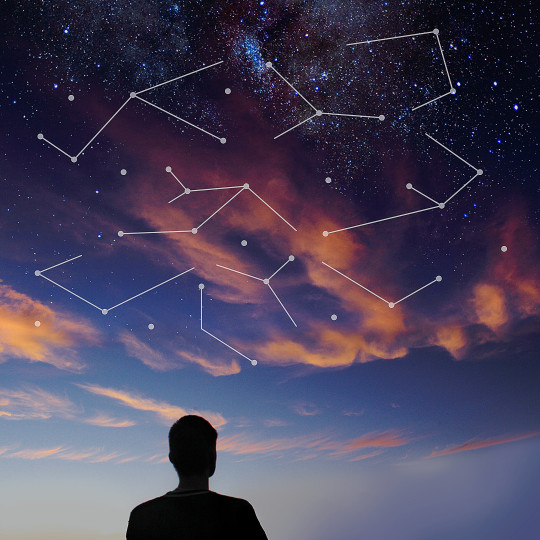
The proper motion of stars across the celestial sphere, which is the result of their movement through the Milky Way, renders many of the constellations unrecognisable.
1 million years
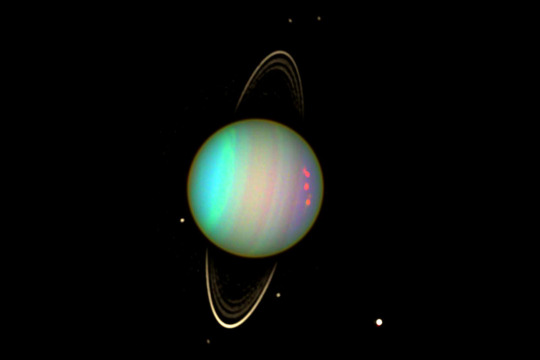
Desdemona and Cressida, moons of Uranus, will likely have collided.
50 million years
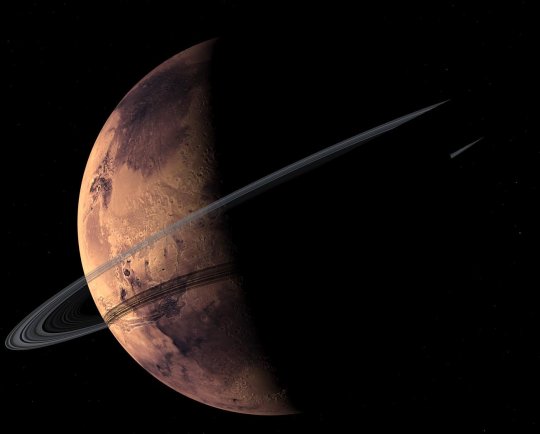
Maximum estimated time before the moon Phobos collides with Mars.
600 million years
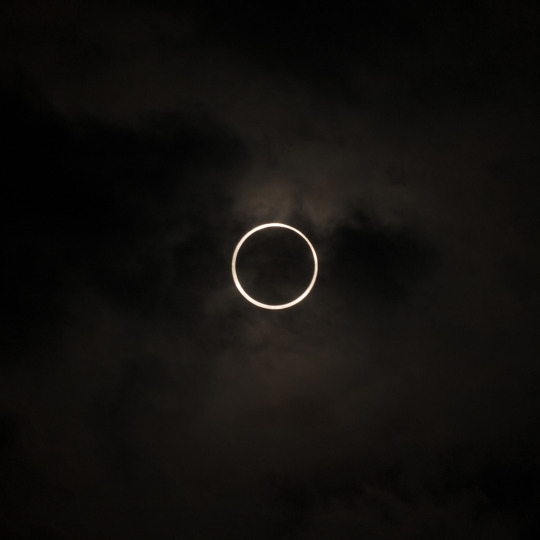
Tidal acceleration moves the Moon far enough from Earth that total solar eclipses are no longer possible.
3 billion years
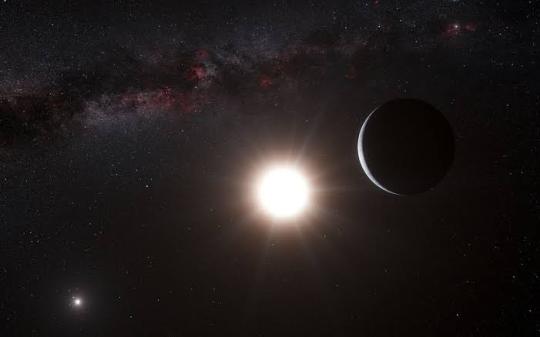
There is a roughly 1-in-100,000 chance that the Earth might be ejected into interstellar space by a stellar encounter before this point, and a 1-in-3-million chance that it will then be captured by another star. Were this to happen, life, assuming it survived the interstellar journey, could potentially continue for far longer.
3.6 billion years
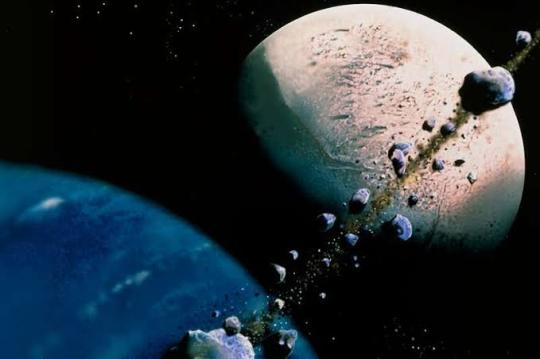
Neptune’s moon Triton falls through the planet’s Roche limit, potentially disintegrating into a planetary ring system similar to Saturn's
4 billion years
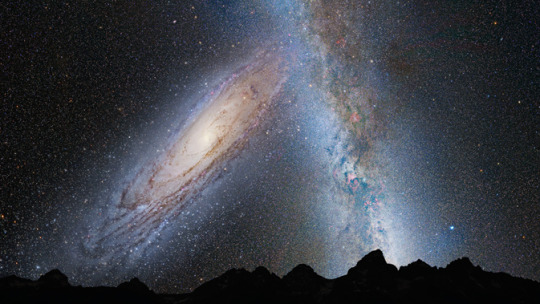
Median point by which the Andromeda Galaxy will have collided with the Milky Way, which will thereafter merge to form a galaxy dubbed “Milkomeda”. The planets of the Solar System are expected to be relatively unaffected by this collision.
5.4 billion years
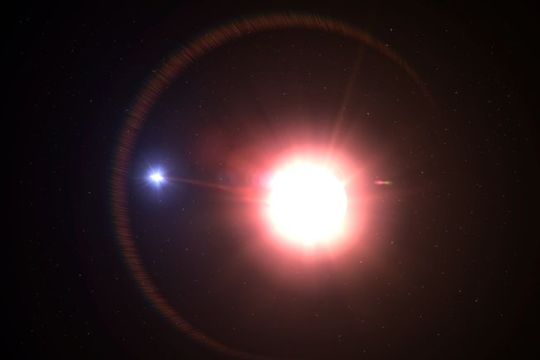
With the hydrogen supply exhausted at its core, the Sun leaves the main sequence and begins to evolve into a red giant.
7.59 billion years
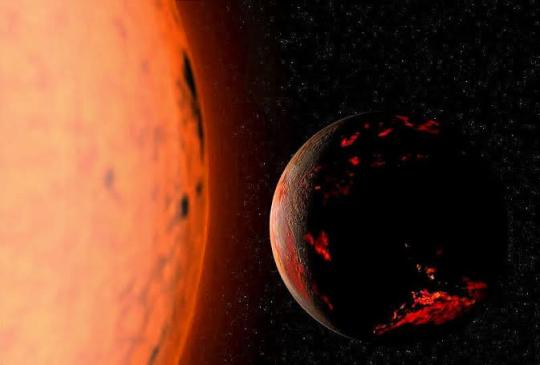
The Earth and Moon are very likely destroyed by falling into the Sun, just before the Sun reaches the tip of its red giant phase and its maximum radius of 256 times the present-day value. Before the final collision, the Moon possibly spirals below Earth's Roche limit, breaking into a ring of debris, most of which falls to the Earth’s surface. During this era, Saturn’s moon Titan may reach surface temperatures necessary to support life. 7.9 billion years: The Sun reaches the tip of the red-giant branch of the Hertzsprung–Russell diagram, achieving its maximum radius of 256 times the present-day value. In the process, Mercury, Venus, and very likely Earth are destroyed.
100-150 billion years
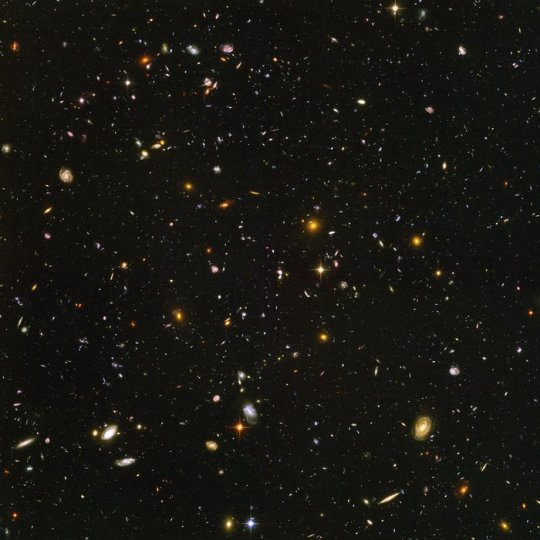
The Universe’s expansion causes all galaxies beyond the former Milky Way’s Local Group to disappear beyond the cosmic light horizon, removing them from the observable universe.
800 billion years
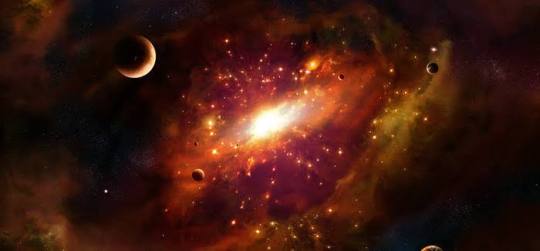
Expected time when the net light emission from the combined “Milkomeda” galaxy begins to decline as the red dwarf stars pass through their blue dwarf stage of peak luminosity.
1014 (100 trillion years)

High estimate for the time until normal star formation ends in galaxies. This marks the transition from the Stelliferous Era to the Degenerate Era; with no free hydrogen to form new stars, all remaining stars slowly exhaust their fuel and die.
1030 years
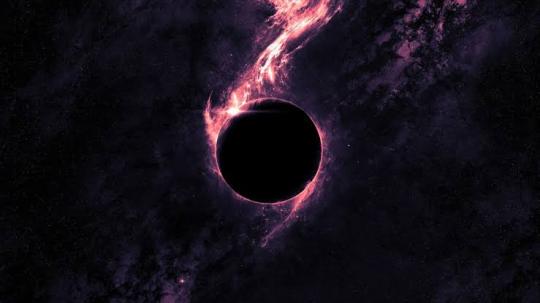
Estimated time until those stars not ejected from galaxies (1%–10%) fall into their galaxies’ central supermassive black holes. By this point, with binary stars having fallen into each other, and planets into their stars, via emission of gravitational radiation, only solitary objects (stellar remnants, brown dwarfs, ejected planetary-mass objects, black holes) will remain in the universe.
2×1036 years

Estimated time for all nucleons in the observable universe to decay, if the hypothesized proton half-life takes its smallest possible value (8.2×1033 years).
5.8×1068 years
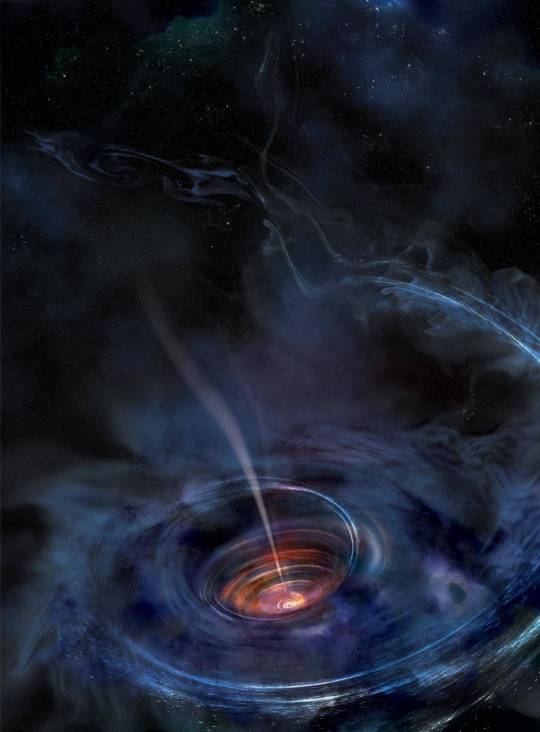
Estimated time until a stellar mass black hole with a mass of 3 solar masses decays into subatomic particles by Hawking radiation.
10^10^10^68 years
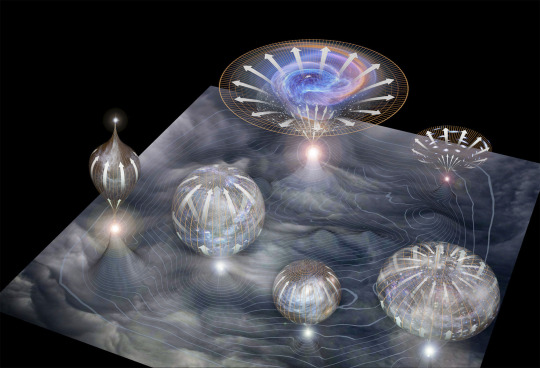
Around this vast timeframe, quantum tunnelling in any isolated patch of the vacuum could generate, via inflation, new Big Bangs giving birth to new universes.
Because the total number of ways in which all the subatomic particles in the observable universe can be combined is 10^10^150 a number which, when multiplied by10^10^10^56, disappears into the rounding error, this is also the time required for a quantum-tunnelled and quantum fluctuation-generated Big Bang to produce a new universe identical to our own, assuming that every new universe contained at least the same number of subatomic particles and obeyed laws of physics within the range predicted by string theory.
(source)
8K notes
·
View notes
Text
How Do You Solve a Problem Like Dark Energy?
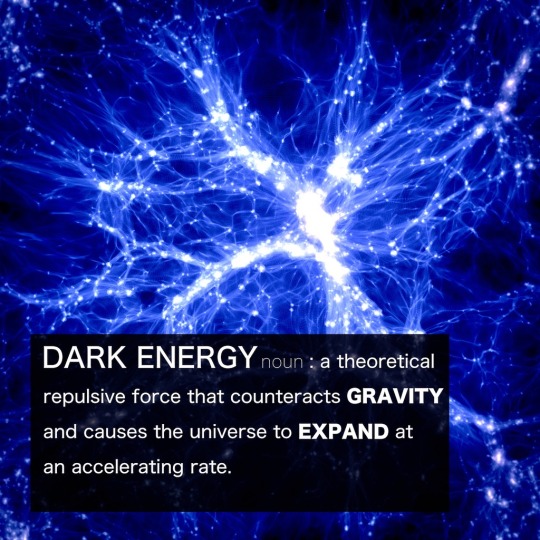
Here’s the deal — the universe is expanding. Not only that, but it’s expanding faster and faster due to the presence of a mysterious substance scientists have named “dark energy.”
But before we get to dark energy, let’s first talk a bit about the expanding cosmos. It started with the big bang — when the universe started expanding from a hot, dense state about 13.8 billion years ago. Our universe has been getting bigger and bigger ever since. Nearly every galaxy we look at is zipping away from us, caught up in that expansion!

The expansion, though, is even weirder than you might imagine. Things aren’t actually moving away from each other. Instead, the space between them is getting larger.
Imagine that you and a friend were standing next to each other. Just standing there, but the floor between you was growing. You two aren’t technically moving, but you see each other moving away. That’s what’s happening with the galaxies (and everything else) in our cosmos … in ALL directions!
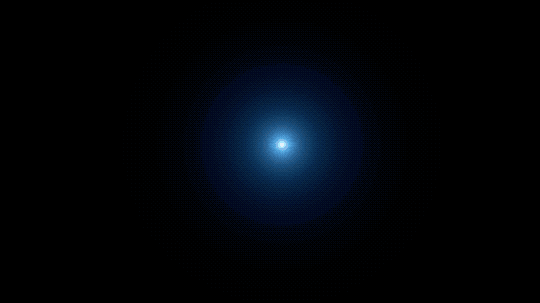
Astronomers expected the expansion to slow down over time. Why? In a word: gravity. Anything that has mass or energy has gravity, and gravity tries to pull stuff together. Plus, it works over the longest distances. Even you, reading this, exert a gravitational tug on the farthest galaxy in the universe! It’s a tiny tug, but a tug nonetheless.
As the space between galaxies grows, gravity is trying to tug the galaxies back together — which should slow down the expansion. So, if we measure the distance of faraway galaxies over time, we should be able to detect if the universe’s growth rate slows down.
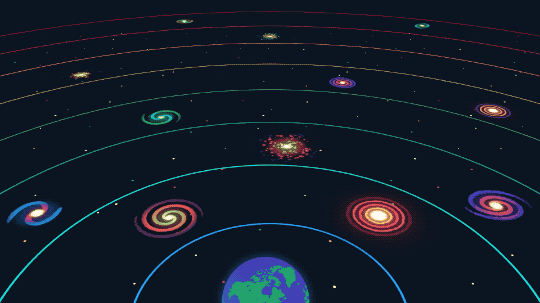
But in 1998, a group of astronomers measured the distance and velocity of a number of galaxies using bright, exploding stars as their “yardstick.” They found out that the expansion was getting faster.
Not slowing down.
Speeding up.
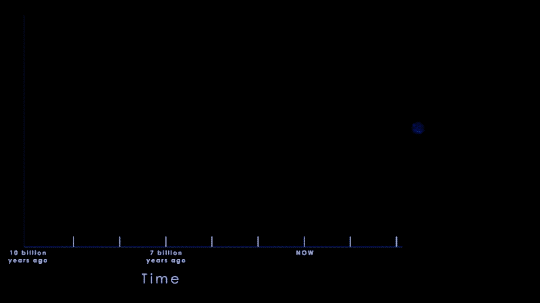
⬆️ This graphic illustrates the history of our expanding universe. We do see some slowing down of the expansion (the uphill part of the graph, where the roller coaster is slowing down). However, at some point, dark energy overtakes gravity and the expansion speeds up (the downhill on the graph). It’s like our universe is on a giant roller coaster ride, but we’re not sure how steep the hill is!

Other researchers also started looking for signs of accelerated expansion. And they found it — everywhere. They saw it when they looked at individual stars. They saw it in large scale structures of the universe, like galaxies, galaxy groups and clusters. They even saw it when they looked at the cosmic microwave background (that’s what’s in this image), a “baby picture” of the universe from just a few hundred thousand years after the big bang.
If you thought the roller coaster was wild, hold on because things are about to get really weird.
Clearly, we were missing something. Gravity wasn’t the biggest influence on matter and energy across the largest scales of the universe. Something else was. The name we’ve given to that “something else” is dark energy.
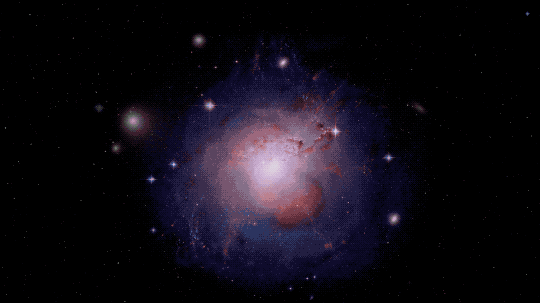
We don’t know exactly what dark energy is, and we’ve never detected it directly. But we do know there is a lot of it. A lot. If you summed up all the “stuff” in the universe — normal matter (the stuff we can touch or observe directly), dark matter, and dark energy — dark energy would make up more than two-thirds of what is out there.
That’s a lot of our universe to have escaped detection!
Researchers have come up with a few dark energy possibilities. Einstein discarded an idea from his theory of general relativity about an intrinsic property of space itself. It could be that this bit of theory got dark energy right after all. Perhaps instead there is some strange kind of energy-fluid that fills space. It could even be that we need to tweak Einstein’s theory of gravity to work at the largest scales.
We’ll have to stay tuned as researchers work this out.
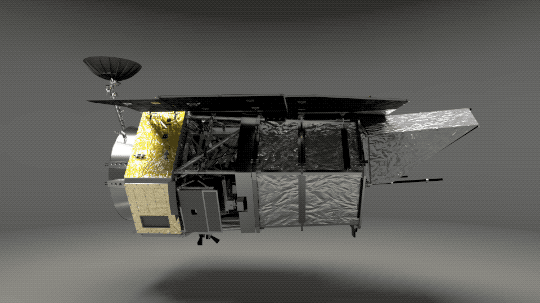
Our Wide Field Infrared Survey Telescope (WFIRST) — planned to launch in the mid-2020s — will be helping with the task of unraveling the mystery of dark energy. WFIRST will map the structure and distribution of matter throughout the cosmos and across cosmic time. It will also map the universe’s expansion and study galaxies from when the universe was a wee 2-billion-year-old up to today. Using these new data, researchers will learn more than we’ve ever known about dark energy. Perhaps even cracking open the case!
youtube
You can find out more about the history of dark energy and how a number of different pieces of observational evidence led to its discovery in our Cosmic Times series. And keep an eye on WFIRST to see how this mystery unfolds.
Make sure to follow us on Tumblr for your regular dose of space: http://nasa.tumblr.com
3K notes
·
View notes
Photo

What’s happening around that star? An unusual spiral structure has been discovered around the Milky Way star R Sculptoris, a red giant star located about 1,500 light years away toward the constellation of the Sculptor (Sculptoris). The star was observed with the new Atacama Large Millimeter/submillimeter Array (ALMA), the most powerful telescopic array observing near millimeter wavelengths, that part of the spectrum situated well beyond red light but before microwaves and radio waves. Data from ALMA observations was used to create a 3D visualization of the gas and dust immediately surrounding the star. A digital slice through this data showed the unexpected spiral structure. Although unusual, a similar spiral pattern was discovered in visible light recently around LL Pegasi. Upon analyzing the data, a hypothesis was drawn that the red giant star in R Sculptoris might be puffing gas toward an unseen binary companion star. The dynamics of this system might be particularly insightful because it may be giving clues as to how giant stars evolve toward the end of their lives – and so release some constituent elements back to the interstellar medium so that new stars may form.
Visualization Credit: ALMA Observatory (ESO/NAOJ/NRAO)
1K notes
·
View notes
Link
4 notes
·
View notes
Text
How Do We Learn About a Planet’s Atmosphere?
The first confirmation of a planet orbiting a star outside our solar system happened in 1995. We now know that these worlds – also known as exoplanets – are abundant. So far, we’ve confirmed more than 4000. Even though these planets are far, far away, we can still study them using ground-based and space-based telescopes.
Our upcoming James Webb Space Telescope will study the atmospheres of the worlds in our solar system and those of exoplanets far beyond. Could any of these places support life? What Webb finds out about the chemical elements in these exoplanet atmospheres might help us learn the answer.
How do we know what’s in the atmosphere of an exoplanet?
Most known exoplanets have been discovered because they partially block the light of their suns. This celestial photo-bombing is called a transit.
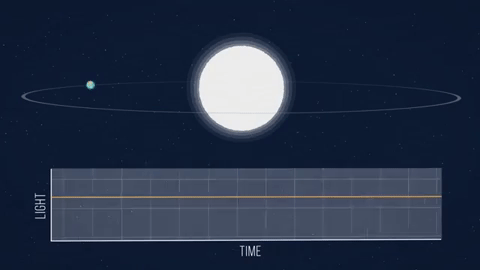
During a transit, some of the star’s light travels through the planet’s atmosphere and gets absorbed.
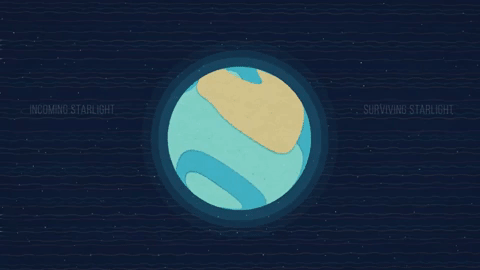
The light that survives carries information about the planet across light-years of space, where it reaches our telescopes.
(However, the planet is VERY small relative to the star, and VERY far away, so it is still very difficult to detect, which is why we need a BIG telescope to be sure to capture this tiny bit of light.)
So how do we use a telescope to read light?
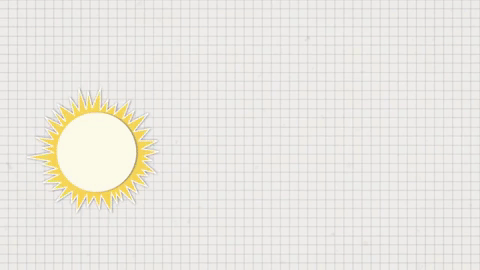
Stars emit light at many wavelengths. Like a prism making a rainbow, we can separate light into its separate wavelengths. This is called a spectrum. Learn more about how telescopes break down light here.
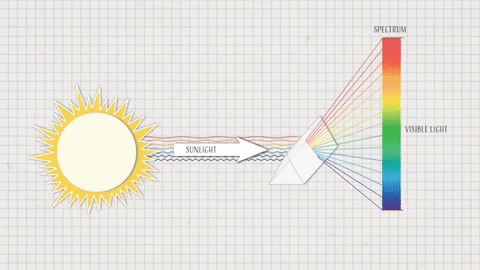
Visible light appears to our eyes as the colors of the rainbow, but beyond visible light there are many wavelengths we cannot see.
Now back to the transiting planet…
As light is traveling through the planet’s atmosphere, some wavelengths get absorbed.
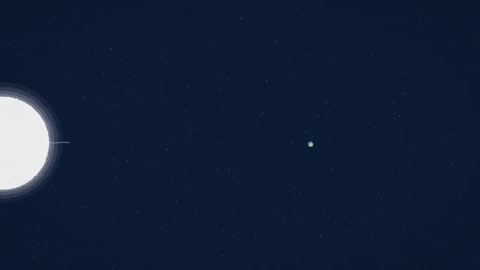
Which wavelengths get absorbed depends on which molecules are in the planet’s atmosphere. For example, carbon monoxide molecules will capture different wavelengths than water vapor molecules.
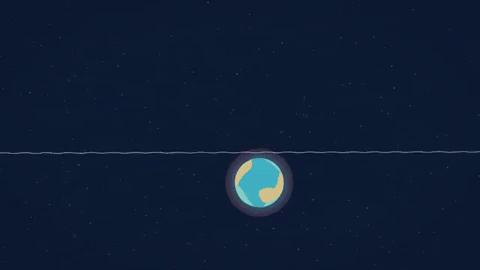
So, when we look at that planet in front of the star, some of the wavelengths of the starlight will be missing, depending on which molecules are in the atmosphere of the planet.
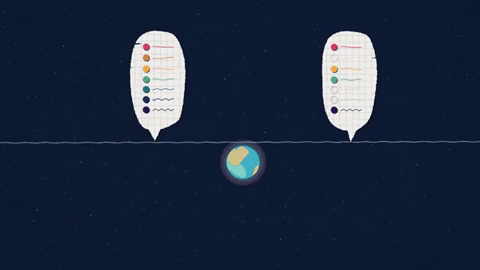
Learning about the atmospheres of other worlds is how we identify those that could potentially support life…
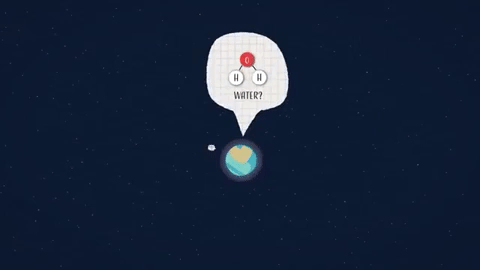
…bringing us another step closer to answering one of humanity’s oldest questions: Are we alone?

Watch the full video where this method of hunting for distant planets is explained:
youtube
To learn more about NASA’s James Webb Space Telescope, visit the website, or follow the mission on Facebook, Twitter and Instagram.
Text and graphics credit Space Telescope Science Institute
Make sure to follow us on Tumblr for your regular dose of space: http://nasa.tumblr.com.
2K notes
·
View notes
Video
Ice Crystals forming inside of bubble
(source - instagram: wonders_of_the_cosmos)
6K notes
·
View notes
Text
A Wrinkle in Space-Time: The Eclipse That “Proved” Einstein Right
One hundred years ago a total solar eclipse turned an obscure scientist into a household name. You might have heard of him — his name is Albert Einstein. But how did a solar eclipse propel him to fame?
First, it would be good to know a couple things about general relativity. (Wait, don’t go! We’ll keep this to the basics!)
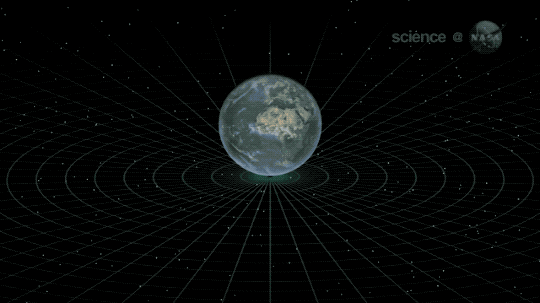
A decade before he finished general relativity, Einstein published his special theory of relativity, which demonstrates how space and time are interwoven as a single structure he dubbed “space-time.” General relativity extended the foundation of special relativity to include gravity. Einstein realized that gravitational fields can be understood as bends and curves in space-time that affect the motions of objects including stars, planets — and even light.
For everyday situations the centuries-old description of gravity by Isaac Newton does just fine. However, general relativity must be accounted for when we study places with strong gravity, like black holes or neutron stars, or when we need very precise measurements, like pinpointing a position on Earth to within a few feet. That makes it hard to test!

A prediction of general relativity is that light passing by an object feels a slight “tug”, causing the light’s path to bend slightly. The more mass the object has, the more the light will be deflected. This sets up one of the tests that Einstein suggested — measuring how starlight bends around the Sun, the strongest source of gravity in our neighborhood. Starlight that passes near the edge of the Sun on its way to Earth is deflected, altering by a small amount where those stars appear to be. How much? By about the width of a dime if you saw it at a mile and a quarter away! But how can you observe faint stars near the brilliant Sun? During a total solar eclipse!
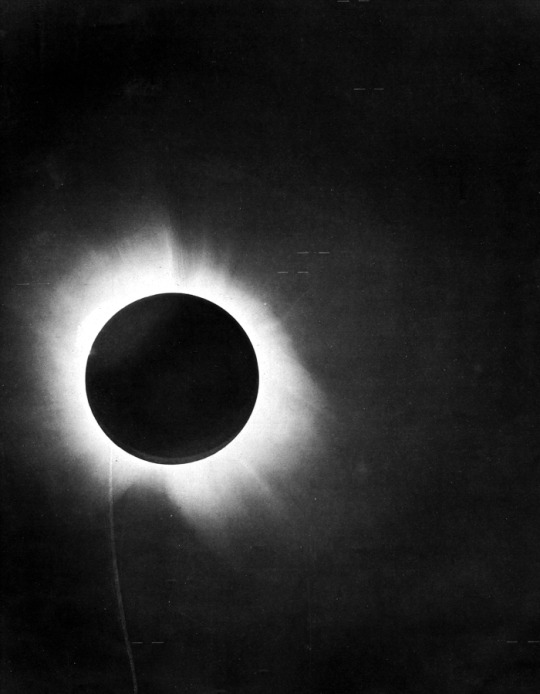
That’s where the May 29, 1919, total solar eclipse comes in. Two teams were dispatched to locations in the path of totality — the places on Earth where the Moon will appear to completely cover the face of the Sun during an eclipse. One team went to South America and another to Africa.
On eclipse day, the sky vexed both teams, with rain in Africa and clouds in South America. The teams had only mere minutes of totality during which to take their photographs, or they would lose the opportunity until the next total solar eclipse in 1921! However, the weather cleared at both sites long enough for the teams to take images of the stars during totality.

The teams took two sets of photographs of the same patch of sky – one set during the eclipse and another set a few months before or after, when the Sun was out of the way. By comparing these two sets of photographs, researchers could see if the apparent star positions changed as predicted by Einstein. This is shown with the effect exaggerated in the image above.
A few months after the eclipse, when the teams sorted out their measurements, the results demonstrated that general relativity correctly predicted the positions of the stars. Newspapers across the globe announced that the controversial theory was proven (even though that’s not quite how science works). It was this success that propelled Einstein into the public eye.
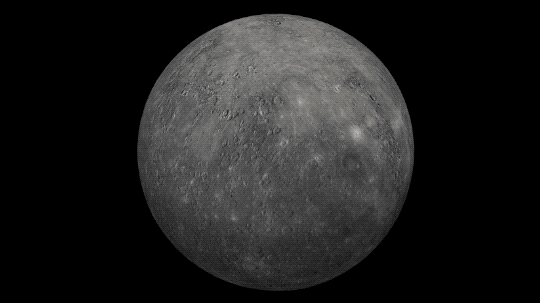
The solar eclipse wasn’t the first test of general relativity. For more than two centuries, astronomers had known that Mercury’s orbit was a little off. Its perihelion — the point during its orbit when it is closest to the Sun — was changing faster than Newton’s laws predicted. General relativity easily explains it, though, because Mercury is so close to the Sun that its orbit is affected by the Sun’s dent in space-time, causing the discrepancy.
In fact, we still test general relativity today under different conditions and in different situations to see whether or not it holds up. So far, it has passed every test we’ve thrown at it.
Curious to know where we need general relativity to understand objects in space? Tune into our Tumblr tomorrow to find out!
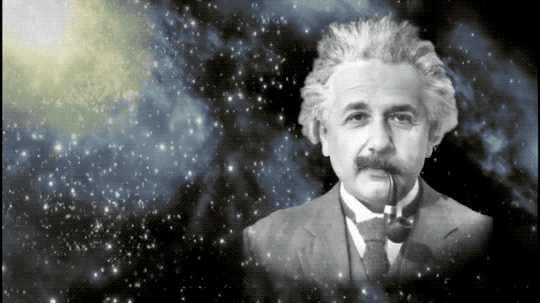
You can also read more about how our understanding of the universe has changed during the past 100 years, from Einstein’s formulation of gravity through the discovery of dark energy in our Cosmic Times newspaper series.
Make sure to follow us on Tumblr for your regular dose of space: http://nasa.tumblr.com.
3K notes
·
View notes
Text
«No adherirme a otras conciencias. No exigir amor. Comprender que, en mí, lo natural es el desamor. Y que si deseo cuidados para mis angustias, debo pagarlos con dinero. Pero espontáneamente, amorosamente, desinteresadamente, jamás los habrá.»
— Alejandra Pizarnik | Diarios
124 notes
·
View notes
Text
Productive Things That Aren’t Studying
washing the dishes
making your bed
tidying your book/dvd shelf/shelves
cleaning the cupboard/wardrobe
reading
sleeping
writing a blog
planning your month/week/day
replying to messages or asks
responding to emails
sorting through letters/mail
clearing your email inbox
organising stationery
clean your sinks
clean your toilets
pet your pet
sort through old clothes
give to charity
go on a walk
go on a run
clean down any surfaces
work out
meal prep
get rid of empty shampoo bottles from the shower
clean out old food from the cupboard/fridge
empty out your school bag
call your parent
unfriend/unfollow people you no longer interact with
watch a TEDTalk
empty the bins/trash
clean the mirrors in your house
hug your pet
wash some clothes
buy any birthday cards/presents that you need to
reply to any old texts
make a tumblr post on productive things that aren’t studying
50K notes
·
View notes
Text
«Entre los hombres que van tras muchas mujeres podemos distinguir fácilmente dos categorías. Unos buscan en todas las mujeres su propio sueño, subjetivo y siempre igual, sobre la mujer.
Los segundos son impulsados por el deseo de apoderarse de la infinita variedad del mundo objetivo de la mujer.
La obsesión de los primeros es lírica: se buscan a sí mismos en las mujeres, buscan su ideal y se ven repetidamente desengañados porque un ideal es, como sabemos, aquello que nunca puede encontrarse.
El desengaño que los lleva de una mujer a otra le brinda a su inconstancia cierta disculpa romántica, de modo que muchas mujeres sentimentales pueden sentirse conmovidas por su terca poligamia.
La segunda obsesión es épica y las mujeres no ven en ella nada conmovedor: el hombre no proyecta sobre las mujeres un ideal subjetivo; por eso todo le resulta interesante y nada puede desengañarlo. Y es precisamente esa incapacidad para el desengaño la que contiene algo de escandaloso».
La insoportable levedad del ser de Milán Kundera
47 notes
·
View notes





